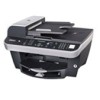Dell 962 All In One Photo Printer User's Guide - Page 80
Regulatory Notices
 |
View all Dell 962 All In One Photo Printer manuals
Add to My Manuals
Save this manual to your list of manuals |
Page 80 highlights
Regulatory Notices FCC Notices (U.S. Only) IC Notice (Canada Only) CE Notice (European Union) CE Mark Notice EN 55022 Compliance (Czech Republic Only) VCCI Notice (Japan Only) MIC Notice (Republic of Korea Only) Polish Center for Testing and Certification Notice BSMI Notice (Taiwan Only) NOM Information (Mexico Only) ENERGY STAR® Compliance Mercury Statement Electromagnetic Interference (EMI) is any signal or emission, radiated in free space or conducted along power or signal leads, that endangers the functioning of a radio navigation or other safety service or seriously degrades, obstructs, or repeatedly interrupts a licensed radio communications service. Radio communications services include but are not limited to AM/FM commercial broadcast, television, cellular services, radar, air-traffic control, pager, and Personal Communication Services (PCS). These licensed services, along with unintentional radiators such as digital devices, contribute to the electromagnetic environment. Electromagnetic Compatibility (EMC) is the ability of items of electronic equipment to function properly together in the electronic environment. While this device has been designed and determined to be compliant with regulatory agency limits for EMI, there is no guarantee that interference will not occur in a particular installation. If this equipment does cause interference with radio communications services, which can be determined by turning the equipment off and on, you are encouraged to try to correct the interference by one or more of the following measures: Reorient the receiving antenna. Relocate the device with respect to the receiver. Move the device away from the receiver. Plug the device into a different outlet so that the device and the receiver are on different branch circuits. If necessary, consult a Dell Technical Support representative or an experienced radio/television technician for additional suggestions. Dell™ devices are designed, tested, and classified for their intended electromagnetic environment. Information Technology Equipment (ITE), including devices, expansion cards, printers, input/output (I/O) devices, monitors, and so on, that are integrated into or connected to the computer should match the















